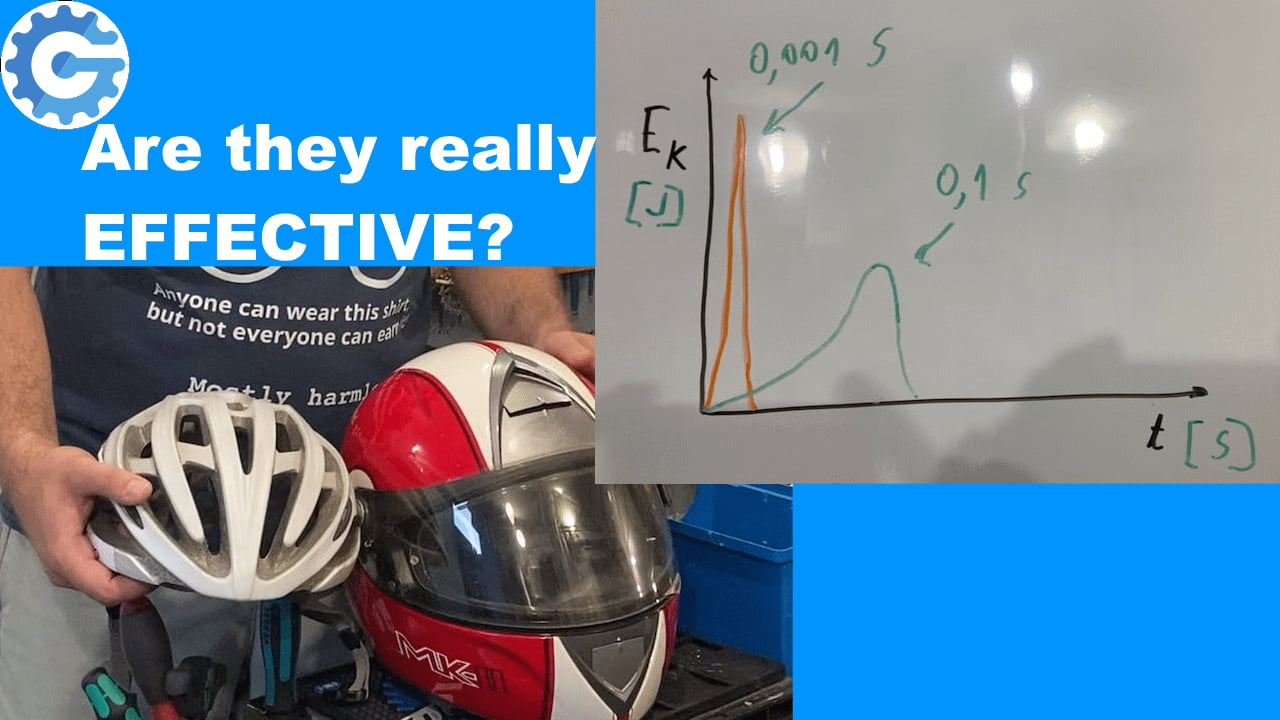If you were to fall of a bike, would you rather have a helmet on? I certainly would. However, it is important to know that bicycle helmets offer surprisingly little protection. I will explain exactly how and why, so you can take that into consideration when assessing risks, and “prevent” helmets from making you less safe, so to speak (no amount of marketing words, cool colours or shapes can change the laws of physics).
TL/DR:
I’ll answer the following questions:
What is the realistic amount of protection you could expect from a cycling helmet?
What kind of helmet should you look for?
Table Of Contents (T.O.C.):
- Introduction and a disclaimer
- Action and reaction – and energy preservation
- Inertia and mass
- Kinetic energy and area of impact
- Area of impact
- How do cushions work?
- Human body
- Bicycle vs Motorcycle helmets
- Best (or the least bad) cycling helmets
- Mythbusting
10.1. Myth 1: Helmet saved my life
10.2. Myth 2: Helmets can make injuries worse
10.3. Myth 3: Mips® - Conclusion
- Cycling helmets video
1. Introduction and a disclaimer
To make it crystal clear: this is not about advocating for or against helmets. It’s about helping you understand the risks and making an informed decision for yourself, by yourself. Over the past decades, I did a lot of research and experimenting (and had dozens of falls and accidents – LOL ). Everything I say here is based on my knowledge, education, and experience. When I gain new information, I will update this article.
With that out of the way, to understand safety measures and equipment, including helmets, we must understand some basic physics. I’ll start with that – explaining it in layman’s terms and using analogies. By the end, you will understand how and why it all boils down to speed change over time.
2. Action and reaction – and energy preservation
There is a ton of marketing drivel out there, and understanding the basic physics can help you see through that and have realistic expectations.
We’ll start with the action and reaction. Newton’s third law of motion states that for every action there is an equal and opposite reaction. You see, when I press my finger against a wall with a certain force, the wall exerts exactly the same amount of force back to my finger – and I can feel that pressure. That is the reaction.

So, if I push hard against a wall or the floor, since they are pretty heavy and hard, the reaction force will result in me moving away from them. If I push a wheeled cart, the cart will move away from me, but if it is heavy and I do it on ice, the reaction force might also move me in the opposite direction. This last example touches upon inertia and kinetic energy that I’ll explain in a bit, but before that, I’ll explain the law of energy preservation.
The law of energy preservation says that energy can’t disappear nor be created out of nothing, but it can only transform from one form to another. So, when I press against a wall, that energy is converted into pressure. If i push on a weeled cart, the energy is transformed into kinetic energy of the cart. If I compress a spring, the energy is converted into spring’s potential energy (it is compressed and ready to spring out – pun intended).
What has this got to do with helmets? Well, safety equipment can’t make the impact energy disappear! It can’t alter the laws of physics. Remember that as it will come in play later.
3. Inertia and mass
Inertia and mass are crucial for understanding how our body (and brain and liver etc.) behave in a crash.
If we put a bicycle and a car on a flat paved road (and put the car in neutral and disengage the hand brake), neither of them will move (even if there is slight wind). Gravity is pulling them alright, but since they are on the level ground, the gravity won’t help us move them.
Now, we can easily push a bike, walking or running with it. We can also stop it when we want to, relatively easily, without even using the brakes. A car, on the other hand – it would take some effort for a strong person to push it to move up to even a walking speed. Likewise, if we saw the car is heading towards a land post, unless there’s someone in the cabin to press the brakes, we would have a hard time pulling a car to a stop once it got up to only walking speed.
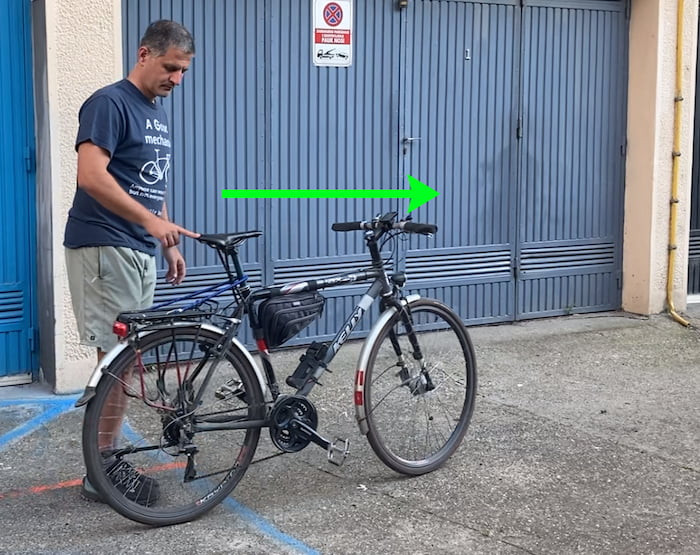

Why is that? Because of a thing called inertia. We define inertia as: “every physical body maintains its state of motion until a force acts upon it” (Newton’s first law of motion).
Let me explain:
The state of motion can be still, or moving at a certain speed. Without inertia, a bicycle would stop moving as soon as we stop pedalling (or pushing it), but we know for a fact that inertia works: if we get up to speed before a hill, the bike will keep moving for a while, even uphill, until the gravity pulls us to a stop. The same goes for trying to move a stationary bike, though it is more easily noticeable with a car.

Why is it more difficult to push or stop a car compared to a bicycle? OK, it’s heavier, but we are on a flat ground, the gravity shouldn’t be playing any part in this. So, if it’s not the weight, then does a car have a higher inertia? Oh, yes, definitely. Inertia is directly proportional to mass. Car’s mass (1,000 kg) is about a hundred times greater than the mass of a bicycle (10 kg). That’s why it takes some effort to push a car from a standstill, while it is trivial to do the same with a bicycle.
A side note:
When gravity affects mass, we call it “weight,” but the weight changes to zero when we are in space, while the mass always remains the same.
Let’s get on with another fun aspect of physics:
4. Kinetic energy and area of impact
Understanding kinetic energy makes all the difference when discussing protective equipment and even active safety. After all: it’s not speeding that kills you – it’s the sudden stopping.
To drive a nail into wood, we could take a hammer, put it on the nail’s head, and press with all our strength and weight. That… would not work very well. However, if we use a flick of our wrist and get the hammer’s head up to speed, we can easily, without much effort and muscle, hammer in the nail. Why is that? Hammer’s head is a lot lighter than our whole body. The answer is kinetic energy.
By getting the hammer’s head up to speed:
- its mass remains the same.
- its inertia remains the same.
- its kinetic energy increases exponentially – by the power of two of speed (squared).
The formula (m – mass, v – speed/velocity, E – kinetic energy):
E = 1/2 x m x v2
We measure and express energy (including the kinetic energy) in Joules [J].
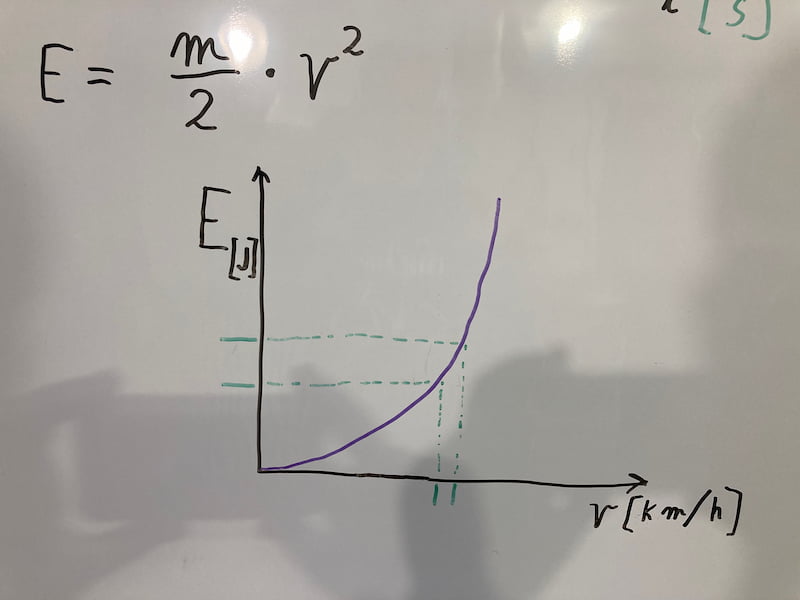
The same applies in reverse: if we reduce the speed by half, the kinetic energy of the impact would decrease to one quarter! We’ll get back to this in a bit.
5. Area of impact
Now I’ll explain why motorcycle helmets have a hard outer shell.
We all know that using the nail upside-down (hitting it on the pointy end, with its head against the wood) doesn’t work. Why? It’s the same kinetic energy, and the same hardness of wood? It’s because the nail’s head is a lot wider than its tip, so it spreads the impact over a wider area.
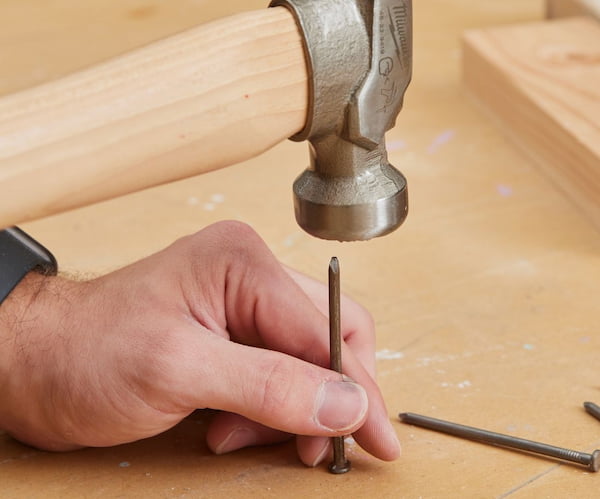
Similarly, if we push against the wall strongly with only one finger, it could hurt. If push with the same force using open palms, the pressure at any part of our hands is a lot lower.
So, it hurts less when we spread an impact over a wider area. That’s good to know.
Motorcycle helmets and some other protective equipment have a hard outer shell for precisely this reason: even if you hit a kerb, the impact of its sharp edge will be spread over a wider area, instead of piercing your skull.
Of course, most protective equipment has some kind of cushion. Let’s dive into that.
6. How do cushions work?
This should help you understand why protective gear is bulky.
We already know that spreading the same impact over a wider area helps reduce the force on any given part of that area. What happens if we make the impact energy take more time to transfer, and what do I mean by that?
If my maths is correct, when an average man slips and falls flat on the ground, the impact energy is around 1,000 Joules.
With those 1,000 J of energy – if I put my hands up straight, elbows locked, and drop into a pushup position, I am highly likely to hurt my palms and break a bone or two. If I do the same thing, but bend my elbows to cushion the blow, I will be fine. Same height, same impact, same kinetic energy, but different results. How exactly does that happen?
With my arms locked, the stopping distance is practically 0 metres, and all the impact’s kinetic energy hits me in an instant.
Cushioning with my arms makes the total 1,000 Joules of energy transfer last longer. I’m increasing the stopping distance (to at least about 25 centimetres) and thus the time that the total energy transfer takes – to about 100 milliseconds. So, “buying” myself just the 0.1 extra seconds makes the difference between broken bones, and a safe “landing.”

I used some rounded averages to do the calculations. Physicist and mathematicians are welcome to correct me on the exact figures, but the principles still remain.
An important caveat is that my muscles must be strong to provide good resistance. If my hands are weak, I will slow down just to a degree, but will then hit the ground with my chest and face taking the rest of the impact’s energy (reduced from the initial 1,000 J, but not to zero).
Cushions in protective equipment and helmets work in a similar way. They increase the stopping distance and make the total kinetic energy transfer process take just a split-second longer. They mustn’t be too hard or firm (since that’s the equivalent of locked elbows and straight hands), but they mustn’t be too soft either (since in that case they will compress too quickly, too easily, instead of absorbing more of the impact’s kinetic energy).
As I said at the start: it boils down to time and distance. There is no magic material that can save you from decellerating too fast. You need a certain thickness in order to provide enough distance which equals time, which equals reduced kinetic energy impacting you at any given time.
7. Human body
A wise man knows his limits. 🙂
Our bodies protect us by enclosing the brain in a hard skull and using the rib cage and stomach muscles to safeguard sensitive internal organs. That works pretty well, but it’s not ideal.
For example, the brain is suspended inside the skull – it floats in a jelly-like substance called cerebrospinal fluid. That cushions minor blows and vibrations, so we don’t get a concussion when we are running or jumping. Yet, if the head (and the skull) stops too abruptly, even if the bones don’t break, the brain will continue moving (remember inertia) and hit against the skull, causing a concussion or worse (if the skull breaks, the brain can get cut against the skull too).
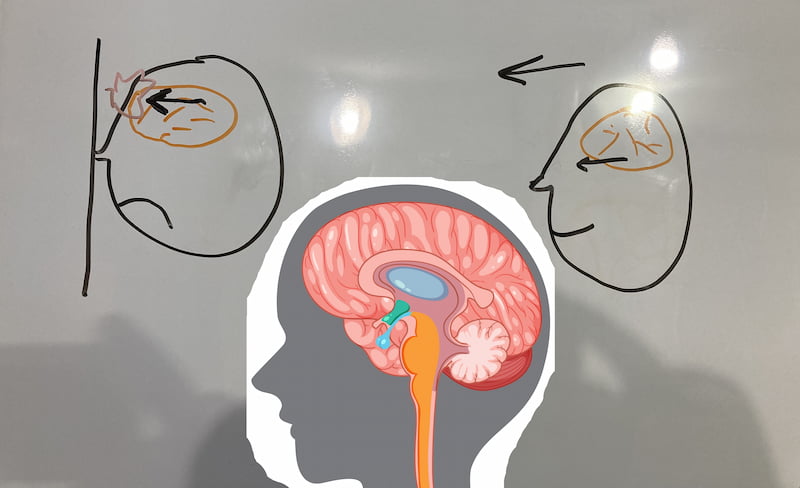
The same thing happens when the skull moves too abruptly (by getting hit when stationary) – ask Mike Tyson for more details. 🙂
Oh, and when we’re talking about Mike Tyson:
The skull and the cerebrospinal fluid do a better job of protecting the brain from translatory movement, then they do from rotational movement of the skull relative to the brain. That is why a punch in the face “just” breaks your nose, but an uppercut punch knocks you out – your skull is forced to rotate fast, with the heavy brain kept in place by its inertia. All the brain’s connections to the nervous system get practically yanked. We’ll get back to that in a bit.
For now, we can conclude that the skull does a pretty good job at distributing the force of impact over a wider area and cushioning the blows, but only to a degree. We can use helmets for extra protection – which leads us to the following chapter.
8. Bicycle vs Motorcycle helmets
Have you ever wondered why motorcycle riders (and racers) don’t wear bicycle helmets? Let’s dive into that, shall we? I’ll start by comparing the two.
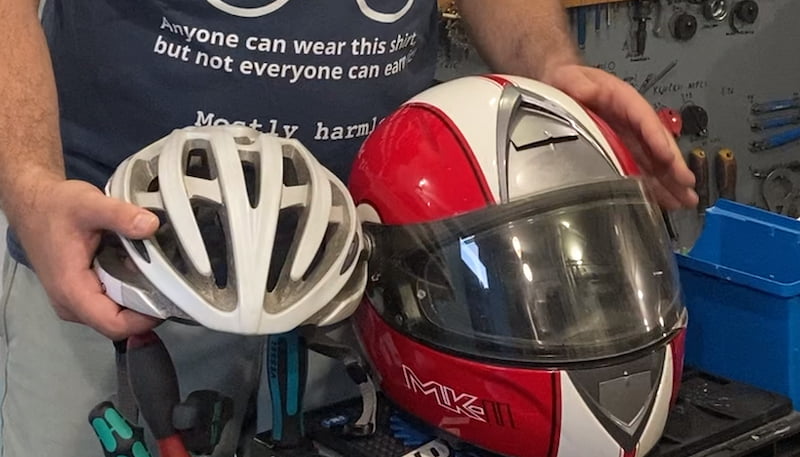
The visor of a road motorcycle helmet shields the rider from the wind, allowing them to see and hear better and avoiding being blinded and deafened by strong winds. But that’s a topic for a separate discussion, since we don’t spend much time at speeds over 40 mph on bicycles. What about other safety features?
- First there is a hard outer shell (made of reinforced plastic to keep it light for comfort, but strong for impacts). The shell is round and smooth and it sort of “melts” in with the shoulders (and the protective back pads if you wear those). It is designed to slide easily and turn direct blows into glancing impacts whenever possible.
- It covers and protects the entire head: face, chin, cheeks, temples, complete back of the head etc.
- Cushioning padding is relatively thick.
- The helmet fits snugly around the entire head (pressing even against the cheeks). This helps the helmet stay braced in place even in a crash, and assures that all the bulk of the helmet works to protect the rider (air gaps add to size & volume but don’t provide any cushioning, unless we are talking about special air bags).
- Good motorbike helmets are tied with a “double D ring,” assuring that the helmet stays in place when buckled – instead of relying on a plastic clip to keep it in place.
Double D straps are self-tightened when you pull on the helmet. You need to move it aside without pulling on the helmet in order to unbuckle. When I was racing, you weren’t allowed on the track without a certified helmet with a double D ring strap. - There is a standardised testing and certification regulation – DOT in the US, ECE 22.06 in the EU, and the “less official” but arguably better US Snell M2020 certificate and UK’s SHARP tests, just to name a few.
High quality downhill bicycle helmets are a lot like motorcycle helmets, but how do the “normal” road and MTB cycling helmets compare to those?
- The outer shell is not as hard & strong, and has huge gaps for ventilation (otherwise we would risk a stroke when cycling up hills in the summer), so they don’t protect very well against sharp object impacts (like hitting a kerb’s edge). It doesn’t gradually narrow down near the neck and shoulders, but it protrudes a bit compared to the riders head around the head’s mid section (vertically), so it poses more risk of catching onto stuff and causing more head rotation.
- It covers only the top of the head, and a bit of the sides, forehead and back – but not nearly all the way. The face is completely unprotected.
- Cushioning padding is usually not as thick.
- Helmet fits just around the top of the head, far from the best possible bracing for impact.
- I’ve never seen one with a double D buckle – it’s usually just a plastic clip to keep the helmet “locked”.
- Safety standards are not nearly as rigorous and practically every cycling helmet would fail any serious motorcycle helmet crash testing. Hence – you never know what you’re really buying.
Could we add more padding to a cycling helmet? We could, but that would make it heavier (neck pains), reduce ventilation (heat stroke in the summer), and more likely to catch onto stuff and cause injury by rotating the head. So, it’s a compromise. The least bad thing we can do to improve safety at least to a very small degree.
Briefly put: a high-quality motorcycle helmet offers several times better protection compared to a high-quality cycling helmet.
To be even more blunt: you could think of your cycling helmet as a slightly improved baseball cap. Why am I saying this and am I exaggerating?
Well… how many times have you heard (or thought or said): “I would not ride there without a helmet?” People usually say that when they assess the risks and conclude there is a chance of an accident and serious injury. That’s perfectly reasonable. The unreasonable part is expecting a decent cycling helmet to prevent serious injuries. My advice would be: either wear a proper full face downhill (or a motorcycle) helmet – or ride more slowly and less risky.
Cycling helmets can help to a degree, but they don’t provide the protection we are led to believe they do by various manufacturers and safety advocates. You may be safer by being more careful and cautious without a helmet, than by taking more risks with a helmet, while overestimating its level of protection.
Before any keyboard warriors start shooting: I’m not telling you to not wear a helmet. I’m saying to take as much (pre)caution as you would be taking without a helmet (or wear a proper, full-face helmet).
Of course, every little helps, so it makes sense to get the best helmet with all the afore-explained limitations.
9. Best (or the least bad) cycling helmets
I don’t sell or advertise helmets, and have no way of testing every single model out there. Still, I’ll try to give you some general guides and recommendations.
Look for helmets that come in several different shell sizes for different head sizes. One size fits all helmets are bulky and, unless your head is the XL size, will be needlessly protruding too far out and increasing the risk of catching onto something and causing more injury. Helmet sizes are like shirts: S, M, L, XL etc, and one size is made for a range of +-2 cm of head circumference (measured 2 cm above the eyebrows).
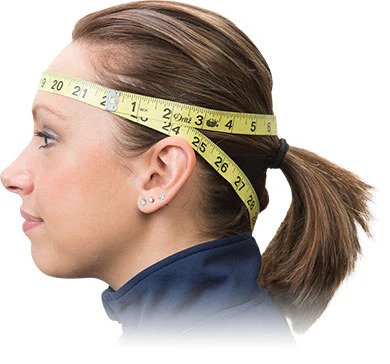
Choose models that are tapered at the ends, so they are more likely to slide, and less likely to catch onto stuff.
Check the Virginia Tech helmet ratings and helmets.org for some info on the tested models.
Test if the helmet fits your head properly. Once you mount the helmet, tighten its adjustment and fasten its strap. You should not be able to move it off your head by pressing it from the forehead upwards and towards the back. It should stay put, without strangling you with its strap. 🙂
10. Mythbusting
This part is not intended to discourage you from wearing a cycling helmet. It is intended to discourage you from taking risks that would require a real full-face helmet for protection.
10.1. Myth 1: Helmet saved my life
“Helmet saved my life” statement is often followed by a picture of a cracked helmet. Helmets, even the cycling ones, do make a difference, no arguing that. However:
I’ve explained the physics and limitations of cycling helmets. So, if a person didn’t end up with a severe concussion, the impact was most probably not strong enough to be fatal – with or without a helmet. A great telling sign is the helmet’s material: if it is squashed, then the helmet did soak up some kinetic energy. But if the helmet is just cracked/split open, without being squashed, it didn’t take much of the impact.

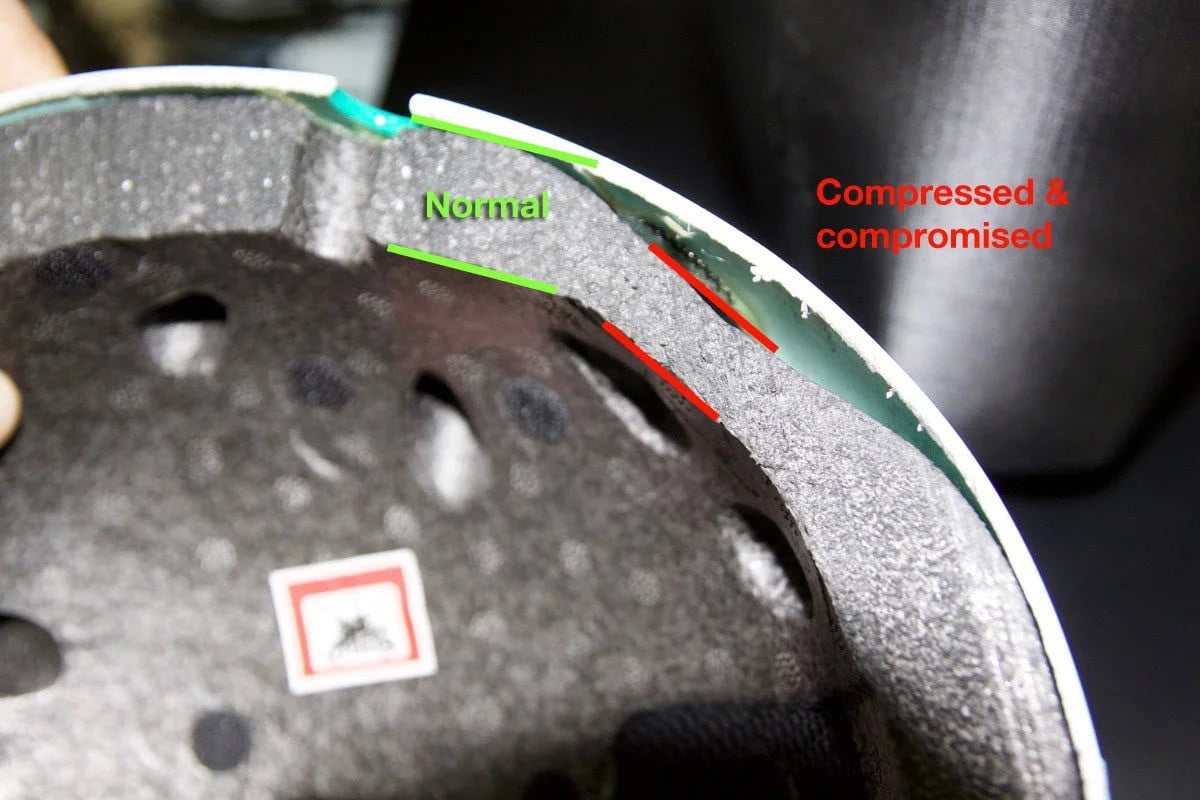
Nonetheless, helmets do make a difference, and sometimes that can be the narrow line between a serious, and a fatal injury. Just have realistic expectations and don’t overestimate their “power.”
10.2. Myth 2: Helmets can make injuries worse
I’ve heard this one too often. Some people advocate against helmets by claiming they can make injuries worse. Sure, there might be a scenario in which a good helmet can make some injuries a bit worse, but the probability of a helmet reducing injuries instead of making them worse is about a billion times higher.
The only scenario in which a helmet can really make things worse is if you take higher risks expecting the helmet to keep you safe – because cycling helmets are in the “better than nothing” category as far as protection goes (but they still are better than nothing).
10.3. Myth 3: Mips®
I must mentiont the famous Mips®. MIPS stands for “Multi-directional Impact Protection System.” The basic idea is that you have a mesh on the inside of your helmet that is placed against your head, and tied to the helmet with weak links.
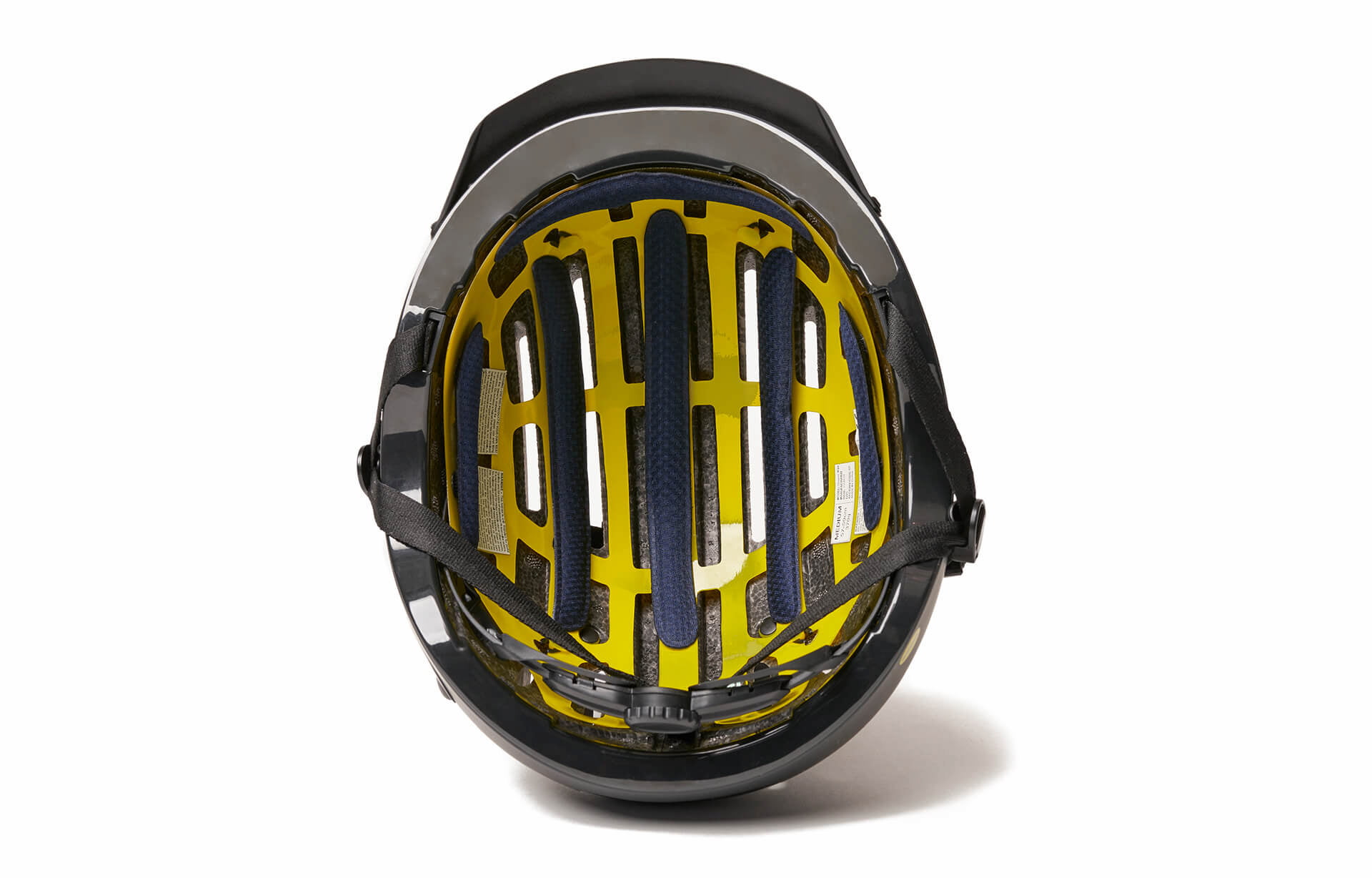
Then, during an impact, if the helmet tries to turn, the weak links break and your helmet rotates free… for about one cm.
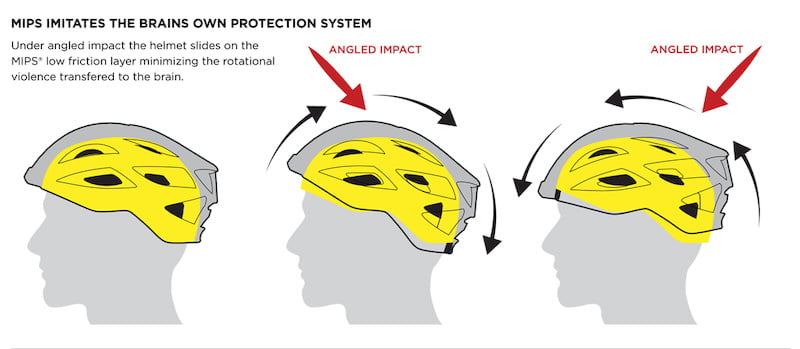
I’ve already explained the danger of sudden head rotation, so Mips should be cool, right? Well… yes and no.
First of all, the Mips mesh takes some space – which means bulkier helmet or less cushioning. Bulkier helmet is more likely to get caught and provides a bigger lever for rotating your head. Less cushioning means more kinetic energy goes to your head, and less is soaked up by the helmet. So, there is a price – not just in terms of money.
Also, helmets can rotate even without the mips – unless you have no hair and your scalp is 100% dry of any sweat (ironically, Mips mesh can also pull on your hear when you are trying to remove your helmet). To make the matters worse, too much helmet rotation can be just as bad as no helmet rotation (for different reasons, but still bad if your goal is to avoid injuries).
Finally, Mips doesn’t work very well in every crash scenario with every Mips helmet model.
Yes, there are good Mips helmets out there, but there are also good helmets without that marketing buzzword.
Mips is a registered trademark, so some folks get a lot of extra money from cyclists who buy Mips helmets, but the main point is that it is not proven to be more effective compared to the, well, good non-Mips helmets.
11. Conclusion
What are the takeaways from all this? Pretty simple:
- Helmets can help you be safer, but only if you don’t overestimate their level of protection when assessing risks.
- It makes sense to get a good helmet – the little difference in the limited amount of protection can make a crucial difference in some scenarios.
12. Cycling helmets video
I’ve also made a video about this topic, with some demonstrations to go along with this discussion:
Last updated:
Originally published:
Help BikeGremlin
stay online & independent
This website is educational, free, objective, and not commercial
(sponsors don’t enjoy paying if you mention all the product downsides that you notice 🙂 ).
How much does a WordPress website cost?
If you find this site to be good and helpful,
and if $5 per month is what you can afford to set aside,
please consider supporting my work with a Patreon donation:

